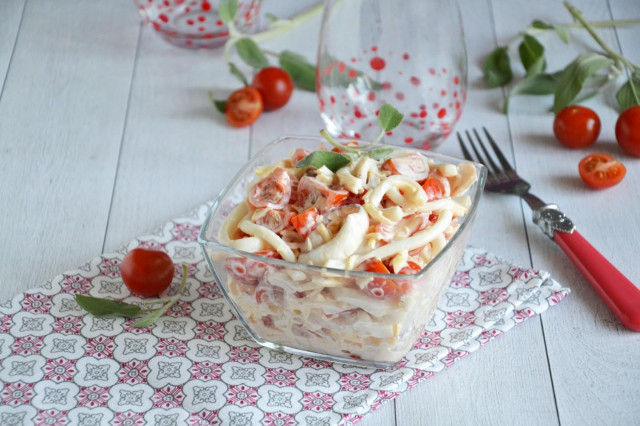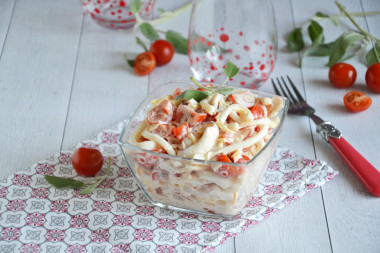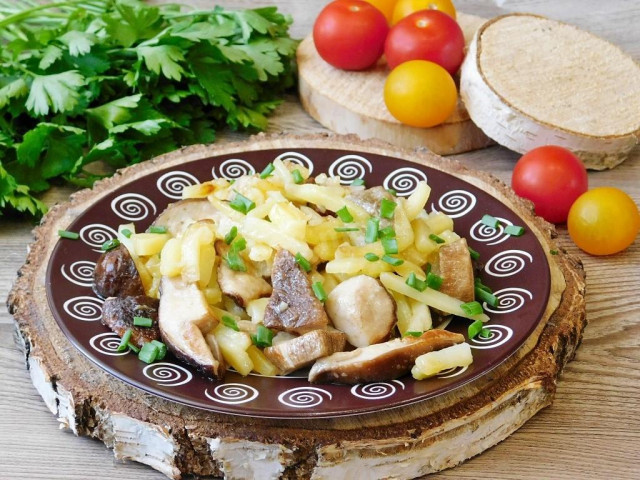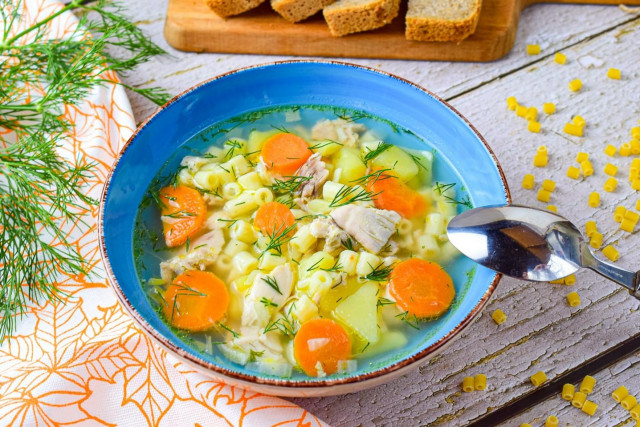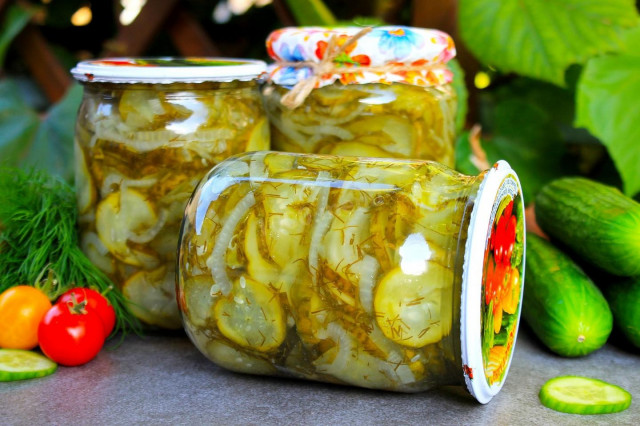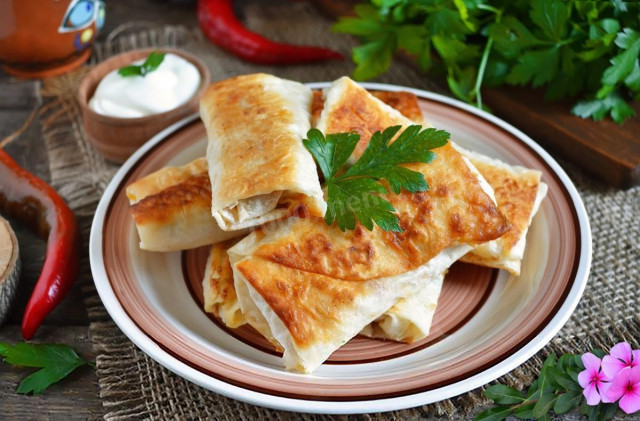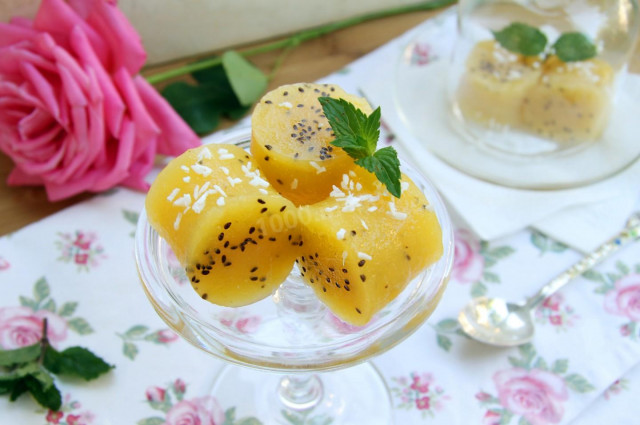Composition / ingredients
Step-by-step cooking
Step 1:
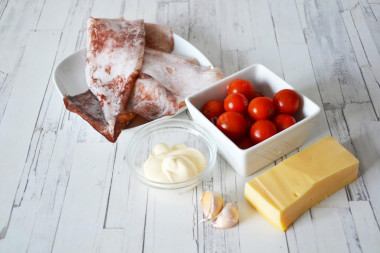
How to make a Red Sea salad with tomatoes and squid? Prepare the ingredients. We will need: fresh or frozen squid, tomatoes (I have cherry tomatoes); cheese; garlic; mayonnaise. If desired, you can add salt and pepper.
Step 2:
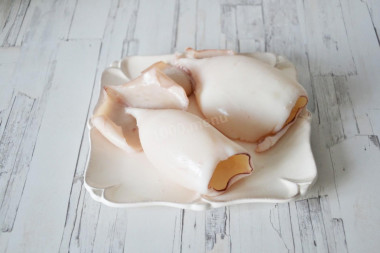
If the squid is frozen, first defrost them. If the carcasses are uncleaned, rinse them thoroughly and peel off the skin and films, remove the chord. Boil the squid one at a time in salted boiling water for 1-2 minutes, then they will retain their shape. Do not cook longer!!! Otherwise, the squid will become hard as rubber and completely tasteless.
Step 3:
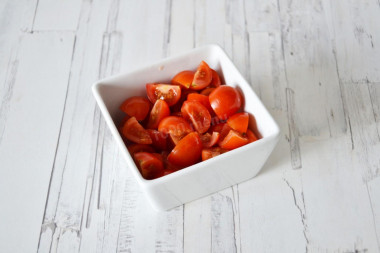
Wash the cherry tomatoes, dry them and cut them into quarters.
Step 4:
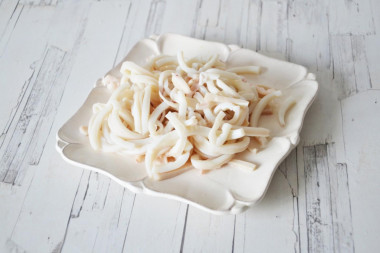
Cool the finished squid, cut into strips.
Step 5:
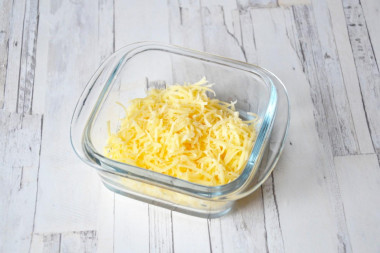
Grate the cheese on a coarse grater.
Step 6:
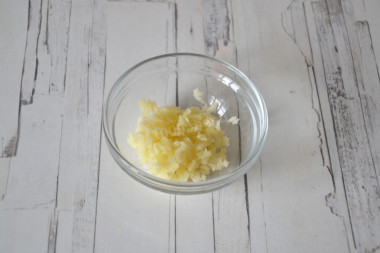
Peel the garlic and pass it through the press.
Step 7:
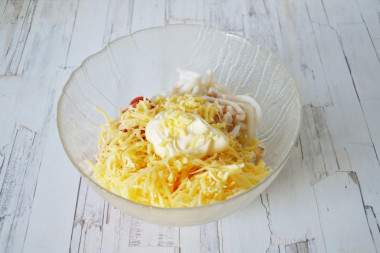
Combine squid, tomatoes and cheese in a salad bowl. Add garlic and mayonnaise passed through the press.
Step 8:
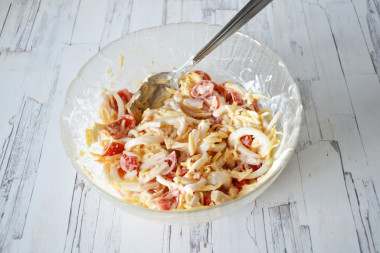
Mix everything thoroughly. If desired, you can add salt and pepper to the salad.
Step 9:
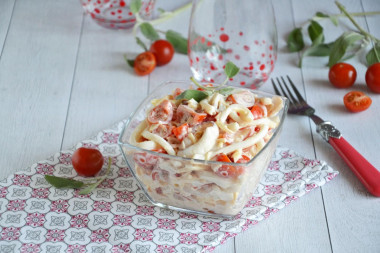
Bon appetit!
Squid can be replaced with crab sticks.
With the same name, a salad with red fish, crab sticks or shrimp is prepared.
You can add 2 boiled eggs to the salad for satiety.
The salad will appeal to all lovers of seafood and squid in particular.
Squid, like almost all seafood, is very rich in protein. And it practically does not contain fats and carbohydrates. Thanks to this, the salad turns out to be hearty and low-calorie.
It is very important to cook squid properly. Another sign of the readiness of squid when cooking - they should turn from beige to white. If there are more than one carcass, then it is better to cook them alternately. Then they won't lose their shape.
Squid meat is valuable because of its low energy value, as well as its chemical composition, which provides the body with the necessary amino acids, especially important in the process of losing weight or during physical exertion. Thanks to the taurine contained in squid, the level of cholesterol in the blood decreases.
Another distinctive feature is the content of a large amount of animal protein in the composition. According to this indicator, squid is not inferior to beef or fish.
It is better to prepare mayonnaise yourself. It will be tastier and healthier. See here interesting
recipes for homemade mayonnaise.
Also, as a dressing, you can use not only mayonnaise, but also sour cream or natural yogurt. They can be taken separately or mixed with mayonnaise in any proportion to your taste - this will reduce the calorie content of the dish.
Caloric content of the products possible in the composition of the dish
- Fried squid - 175 kcal/100g
- Boiled squid - 110 kcal/100g
- Squid fresh - 74 kcal/100g
- Dutch cheese - 352 kcal/100g
- Swiss cheese - 335 kcal/100g
- Russian cheese - 366 kcal/100g
- Kostroma cheese - 345 kcal/100g
- Yaroslavsky cheese - 361 kcal/100g
- Altai cheese 50% fat content - 356 kcal/100g
- Soviet cheese - 400 kcal/100g
- Cheese "steppe" - 362 kcal/100g
- Uglich cheese - 347 kcal/100g
- Poshekhonsky cheese - 350 kcal/100g
- Lambert cheese - 377 kcal/100g
- Appnzeller cheese with 50% fat content - 400 kcal/100g
- Chester cheese with 50% fat content - 363 kcal/100g
- Edamer cheese with 40% fat content - 340 kcal/100g
- Cheese with mushrooms of 50% fat content - 395 kcal/100g
- Emmental cheese with 45% fat content - 420 kcal/100g
- Gouda cheese with 45% fat content - 356 kcal/100g
- Aiadeus cheese - 364 kcal/100g
- Dom blanc cheese (semi-hard) - 360 kcal/100g
- Lo spalmino cheese - 61 kcal/100g
- Cheese "etorki" (sheep, hard) - 401 kcal/100g
- White cheese - 100 kcal/100g
- Fat yellow cheese - 260 kcal/100g
- Altai cheese - 355 kcal/100g
- Kaunas cheese - 355 kcal/100g
- Latvian cheese - 316 kcal/100g
- Limburger cheese - 327 kcal/100g
- Lithuanian cheese - 250 kcal/100g
- Lake cheese - 350 kcal/100g
- Gruyere cheese - 396 kcal/100g
- Garlic - 143 kcal/100g
- Salad mayonnaise of 50% fat content - 502 kcal/100g
- Light mayonnaise - 260 kcal/100g
- Provencal Mayonnaise - 624 kcal/100g
- Provencal mayonnaise - 627 kcal/100g
- Table mayonnaise - 627 kcal/100g
- Cherry tomatoes - 15 kcal/100g

